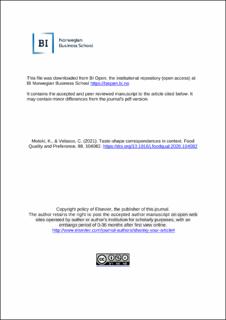| dc.contributor.author | Motoki, Kosuke | |
| dc.contributor.author | Velasco, Carlos | |
| dc.date.accessioned | 2022-01-04T12:39:32Z | |
| dc.date.available | 2022-01-04T12:39:32Z | |
| dc.date.created | 2020-09-09T15:07:27Z | |
| dc.date.issued | 2020 | |
| dc.identifier.citation | Food Quality and Preference,2021,March, 88 | en_US |
| dc.identifier.issn | 0950-3293 | |
| dc.identifier.uri | https://hdl.handle.net/11250/2835987 | |
| dc.description.abstract | A significant body of research demonstrates the existence of taste-shape correspondences. People associate tastes and visual shapes non-randomly. For example, round shapes are associated with sweet taste, while angular shapes are associated with sour and bitter tastes. Previous studies have focused on one-to-one taste-shape associations, where either geometrical shapes or shapes on a product’s packaging have been presented in isolation and evaluated separately. However, in real-life product displays, products are typically surrounded by other products. We examined whether shape contexts can influence the taste expectations associated with target products across five experiments (n = 1087) using geometrical and shapes on the packaging varying in curvature. Participants saw a display set (target shape in the middle surrounded by shapes on both sides) and evaluated the target shape in different taste scales. The first two experiments (within-participants design) failed to reveal that shape contexts can influence the taste expectations of the target. However, the subsequent three experiments (between-participants design) consistently demonstrated that shape contexts influence taste expectations associated with the target. In the latter experiments, we manipulated only the surrounding shapes and fixed target shapes as neutral (intermediate between angular and round shapes). When the surrounding shapes were angular (vs. round), the target shapes were rated as sweeter/more umami and less sour/salty/bitter. Emotions (valence and arousal) mediated the relationship between shape contexts and taste expectations. We discuss the results in light of the theory on crossmodal correspondences and relative compatibility effects. The findings provide insights for food marketers when it comes to designing product package displays to convey taste information more effectively. | en_US |
| dc.language.iso | eng | en_US |
| dc.publisher | Elsevier | en_US |
| dc.rights | Attribution-NonCommercial-NoDerivatives 4.0 Internasjonal | * |
| dc.rights.uri | http://creativecommons.org/licenses/by-nc-nd/4.0/deed.no | * |
| dc.title | Taste-shape correspondences in context | en_US |
| dc.type | Journal article | en_US |
| dc.type | Peer reviewed | en_US |
| dc.description.version | acceptedVersion | en_US |
| dc.source.volume | 88 | en_US |
| dc.source.journal | Food Quality and Preference | en_US |
| dc.identifier.doi | 10.1016/j.foodqual.2020.104082 | |
| dc.identifier.cristin | 1828473 | |
| dc.source.articlenumber | 104082 | en_US |
| cristin.ispublished | false | |
| cristin.fulltext | postprint | |
| cristin.qualitycode | 1 | |

